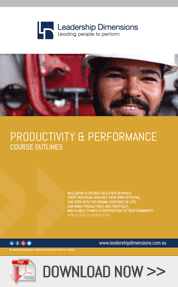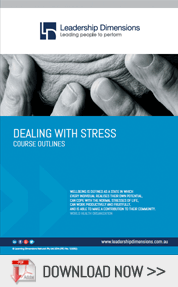 Do mature workers really add value to a business?
Do mature workers really add value to a business?
Bruce Helyard – Senior Facilitator, Safety Dimensions and Leadership Dimensions.
Subject to the passing of legislation, the Federal government is attempting to keep older workers in the workforce though with $304 million of incentives for businesses who recruit mature workers. It’s planned that employers will receive $10,000 per worker hired over 50, staged out over 2 years of employment.
Employers will receive $3,000 after six months of employment, $3,000 after a year of employment, a further $2,000 after 18 months and another $2,000 after two years. Recent notice from the 2014/2015 Australian Government Budget.
Note: This is subject to the passing of legislation
But what’s the business case for this funding and what’s the ROI on older workers – do mature-aged workers really add value to a business?
Learning Dimensions Network (the parent company of Leadership Dimensions) is proud that 44% of our workforce is over 50 with our team ranges in age from 26 to 72.
So what’s the evidence mature workers add value?
- Evidence shows that mature workers deliver an average net benefit to organisations worth about $2,000 plus per year, compared to other workers due to high retention rates, lower absenteeism, decreased recruitment costs and a greater return on investment. (From a 2000 Melbourne JobsEast Study)
- There is evidence that if an organisation engages more mature age workers, allows them flexibility (working part-time from home) and continues in their skill development – it will add an estimated $48 billion to the GDP over the next 12 years. (ABS 2012)
- Experienced mature aged workers have built up a knowledge and skills during their time at work. A daily habits study of 4,000 employees showed that workers over 50 years old consistently performed at their best for 7 hrs out of an 8 hr day ¦an achievement that younger workers cannot match. (From a study by Australian Health Management 2006 called Baby Boomers give employers more bang for their buck.)
- We are living longer and healthier lives. The average age of life expectancy in Australia in 2014 is 83 for males and 86 for females. In 1908 the retirement age was 65 and very few lived beyond that age. Now if we retire at 65 we have 20-30 years more of living. 75% of Australians aged 55-64 report their health as good to excellent and the verbal skills, communication and intelligence remain unchanged as a person ages. (OECD, 2006 “Live Longer Work Longer)
- Mature age workers also tend to take less days off due to illness and care for others. They are also less likely to experience work related injuries. (ABS 2006)
- Mature age workers are more punctual, loyal, possess and display a strong work ethic. They also have an ability to work autonomously.
- It seems that the personnel who have both extensive life and work experiences become valuable assets to an organisation. They display strong problem solving and trouble shooting skills.
- Mature age workers seem to display more loyalty than other age groups. There is much evidence that workers aged over 55 are less likely to change jobs than workers aged 20-24. Many young workers will move on from an employer after 2 years (if no promotion is apparent or offered). Mature age workers will stay for a median time of 8.7 years with job flexibility and skill acknowledgement as the key retainers. (ABS 2006 Labour Mobility Survey.)
- Research from the ANZ Bank (2008) declared that it costs 1.7 times the salary bill to replace a person in the workplace over the next 15 months and even then the best transfer of workplace skills and knowledge is a maximum of 70% – this means there is a 30% gap/loss suffered by a business due to a staff member loss.
- Mature age workers are also becoming much more technologically competent. They are fast embracing the new technologies and this can also be a strong asset for businesses.
- Mature age workers make good mentors for the younger, less experienced workers. This can be used to embed a great vision and legacy for many businesses.
With the above evidence in mind, do you believe that mature age workers would add value to your business? If so, which of the above points are specifically relevant to you and that you have a strong alignment with?
 Furthermore, the updated Age Discrimination Act (2004) states that Managers in organisations are responsible for:
Furthermore, the updated Age Discrimination Act (2004) states that Managers in organisations are responsible for:
- Educating all employees about age discrimination and non compulsory retirement legislation.
- Encouraging respect for the skills and experience of mature age employees, including current employees for upcoming vacant positions.
- Ensuring that personnel decisions are made on the basis of work related performance criteria only and that the application of all personnel policies is age neutral.
- Addressing incorrect age stereotyping or assumptions in relation to training and career development.
- Basic training programs on formal assessment of all employees’ skills and the agency’s needs
- Providing opportunities for all employees to maximise their potential, irrespective of age.
Employees within businesses are also required to¦
- Encourage all to participate in the development, implementation and evaluation of all policies that affect them at work.
- Be responsible to not discriminate against other employees based on their age.
- Be aware that they are not a homogeneous group and will have different needs and strengths and characteristics.
So, if your organisation wants to leverage these benefits and comply with the Age Discrimination Act (2004), you need to ask the big questions and be willing to take action.
Ask:
- How well does your organisation recruit and apply equal employment opportunities (EEO) for mature age workers?
- How does your organisation manage mature age workers?
- How does your business train mature age workers?
- How does your business look after the wellbeing of mature age workers and how does it create an environment that encourages a good work life balance?
- Is your business willing to allow mature age workers to be flexible about their careers in a changing work environment?
- How does your business set up an age-balanced skills development program?
- How does your business maintain a workplace that is healthy and safe for all employees of all ages?
Does your business need help to leverage the benefits of mature age workers?

Our sister division Leadership Dimensions can help you adapt your business to the mature age workforce and address the above questions.
This requires a commitment to an age-balanced workforce rather than costly modifications. Leadership Dimensions specialise in the performance, productivity, wellbeing, retention and development of your people. Some of the relevant courses we offer are:
- Transformational Leadership
- Leading Others Through Change
- Coaching and Mentoring.
- Building High Performance Teams
- The Emotionally Intelligent Leader
- Talent Management
- Manager’s Role in Reducing Stress in the Workplace
- Leaving a Legacy
- Innovation and Continuous Improvement
Visit www.ldn.com.au/leadershipdimensions or download our program outlines
Our programs can facilitate the development of of key strategies within your business that:
- Creates a workplace that provides EEO for all workers, regardless of age
- Introduces a recruitment strategy that helps you draw the best talent from a wide talent pool
- Introduces an age-balanced skills development program that involves mentoring, buddying, coaching and addressing special needs
- Create a work environment that encourages workers to balance their personal lives with work responsibilities
- Encourages mature age workers to be flexible and forward thinking about their careers in a changing world
- Sets up a sustainable safe and healthy workplace for all who come in contact with your business
- Implements redundancy policies that do not discriminate.
Young, old. Just words George Burns




